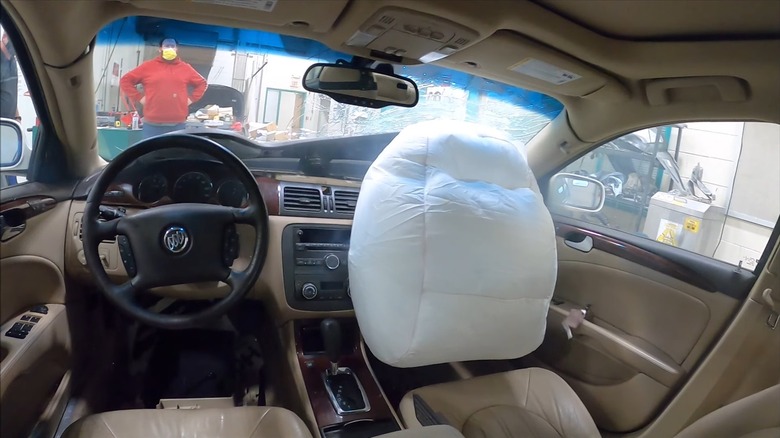
It's possible to drive a vehicle after airbags have deployed, but it's not advisable for several reasons. According to IIHS, frontal airbags for occupants not wearing a seatbelt will activate when striking a solid object between 10 and 12 miles per hour, and in cases where a seatbelt is buckled, they may require greater force, such as an impact at around 16 miles per hour. While these low speeds might not sound too serious, they are unfortunately fast enough to cause lasting damage to the vehicle.
In some cases, the deployment of an airbag severely cracks the windshield, creating a visibility issue. There could also potentially be structural problems with the car following a collision, which could reduce overall safety. In addition, you could pose a greater threat to other motorists should you get into another accident.
Depending on how severe the vehicle has been marred during a collision, you could have issues with insurance coverage or even legal troubles in some cases. One thing is for sure, replacing airbags is expensive and you'll need to check whether insurance will cover the cost. While an airbag deployment doesn't automatically equal the insurance company declaring it a total loss, depending on the car's value and cost of repairs, it is a possibility. If your vehicle is decided to be "totaled," you can keep it, but must consult the DMV, get it properly fixed-up, and complete the process of receiving a rebuilt title.
Read more: 10 Used Cars You Can Safely Buy With Over 100,000 Miles
Airbag Exposure Side Effects And Smell

According to the NHTSA, frontal airbags are responsible for preventing more than 50,000 deaths over the last three decades, and further developments have extended to other vehicles as well. Now you can equip motorcycle airbag vests to protect you in a crash. However, following their deployment, it might not be a good idea to spend time near them. For example, when these devices sense an impact and engage, they release a powdery substance, which could include small amounts of sodium hydroxide. This chemical can cause eye and skin irritation in low doses, which is likely going to make your time on the road uncomfortable.
If safety, legality, and even chemical irritants aren't enough to dissuade you from driving around with blown airbags, perhaps the smell will. Sodium azide is a toxic material used in airbags, but is thoroughly eliminated following a deployment and transformed into inert nitrogen gas. However, while the threat of toxicity has been reduced, you will smell a combination of melting rubber or burning fabric that acts as the opposite of a car air freshener. Even worse, the smokey fumes have been speculated to potentially worsen asthma symptoms or cause inflammation in the lungs. So, instead of continuing to drive around with deployed airbags, you should consider getting towed to an auto collision repair shop for an immediate evaluation.
Want the latest in tech and auto trends? Subscribe to our free newsletter for the latest headlines, expert guides, and how-to tips, one email at a time.
Read the original article on SlashGear.











